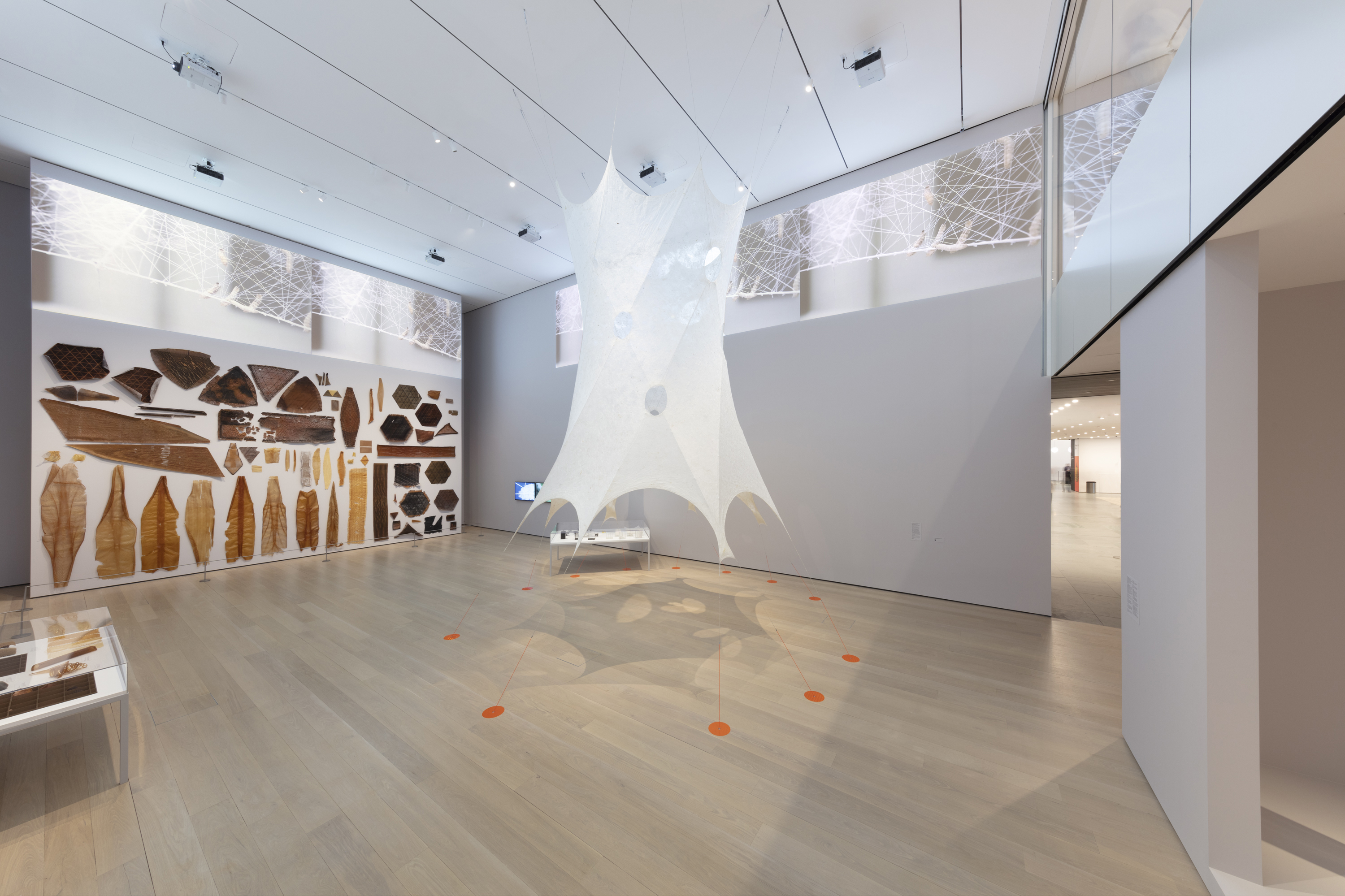Pavilion
2019–2020
Cambridge, MA + Abano Terme, IT + New York, NY

“Digital Image © 2020 The Museum of Modern Art, New York.” Photographed by Denis Doorly
Commissioned for the exhibition Neri Oxman: Material Ecology︎ at the Museum of Modern Art, New York, in 2020, Silk Pavilion II stands at six meters tall and five meters wide. Building on research developed for Silk Pavilion I ︎, this successor project tackled challenges associated with scale and sericulture.
The project utilizes an integrated kinetic mandrel designed to guide the natural spinning motion of the silkworms through clockwise rotation, fusing technology and biology to unite the woven and the spun.
Realized as part of research project conducted in the Mediated Matter Group at MIT Media Lab ︎
Research Team ︎
João Costa, Christoph Bader︎ , Sunanda Sharma︎, Felix Kraemer︎, Susan Williams︎, Jean Disset︎ and Neri Oxman ︎ Undergraduate researcher: Sara Wilson
Contributors ︎
Davide Biasetto, Il Brolo Società Agricola SRL, Padua; Levi Cai; Silvia Cappellozza and Alessio Saviane, Council for Agricultural Research and Agricultural Economics Analysis (CREA-AA), Bologna; Natalia Casas; Kelly Egorova; Fiorenzo Omenetto, Tufts University; Sol Schade, Advanced Functional Fabrics of America (AFFOA); James Weaver, Wyss Institute, Harvard University; Nitzan Zilberman; Bodino; Front Inc.; MIT Media Lab
︎
The project utilizes an integrated kinetic mandrel designed to guide the natural spinning motion of the silkworms through clockwise rotation, fusing technology and biology to unite the woven and the spun.
Realized as part of research project conducted in the Mediated Matter Group at MIT Media Lab ︎
Research Team ︎
João Costa, Christoph Bader︎ , Sunanda Sharma︎, Felix Kraemer︎, Susan Williams︎, Jean Disset︎ and Neri Oxman ︎ Undergraduate researcher: Sara Wilson
Contributors ︎
Davide Biasetto, Il Brolo Società Agricola SRL, Padua; Levi Cai; Silvia Cappellozza and Alessio Saviane, Council for Agricultural Research and Agricultural Economics Analysis (CREA-AA), Bologna; Natalia Casas; Kelly Egorova; Fiorenzo Omenetto, Tufts University; Sol Schade, Advanced Functional Fabrics of America (AFFOA); James Weaver, Wyss Institute, Harvard University; Nitzan Zilberman; Bodino; Front Inc.; MIT Media Lab
︎
In a departure from Silk Pavilion I, this structure is comprised of three interrelated layers. Its innermost primary structure is made of one-dimensional, braided steel wire ropes, while the secondary structure is a two-dimensional knit fabric onto which silkworms are positioned. The outermost layer is a three-dimensional structure biologically spun with the help of some 17,000 silkworms sourced in the Veneto region of Italy where the tradition of sericulture and silk manufacturing has been a part of its history since 12th century Renaissance.
Over the course of 10 days, the silkworms spun horizontally across the base structures. As they progressed, a rotating mechanism guided their spinning motions upwards. The resulting density of the silk layer–influenced by change in light and heat–varies across the structure. The holes in the knit layer, created as a result of the interaction with silkworm excrement, are strategically placed to release tensile stress.
Over the course of 10 days, the silkworms spun horizontally across the base structures. As they progressed, a rotating mechanism guided their spinning motions upwards. The resulting density of the silk layer–influenced by change in light and heat–varies across the structure. The holes in the knit layer, created as a result of the interaction with silkworm excrement, are strategically placed to release tensile stress.

︎︎︎︎︎



︎︎︎

︎︎︎︎︎︎︎︎︎︎︎︎
A scanning mechanism was set up in order to allow for tracking of structural changes over the course of production. The system encompasses a Lidar scanner working in tandem with a rotary encoder and prepared DC motor to create a point cloud data.
As the traditional process of harvesting silk from the cocoon kills the larva, sericulture has been criticized by animal welfare and rights activists. In the textile and silk industry today, silkworms are exterminated while in their cocoon, dissolving the adhesive that glues one strand of silk to the layers below. This process allows a single silk strand to be unrolled from the cocoon but disrupts the life cycle and development of the organism. As the Silk Pavilion demonstrates, structures can influence silkworms to spin in sheets instead of cocoons.
The project illustrates how these compact and unique insects can act not only as living looms but as co-designers uniting with humans to design and construct architectural-scale structures embodying co-fabrication for cohabitation.
︎︎
︎︎︎
︎︎︎︎︎︎
︎

︎︎︎︎︎︎︎︎︎︎︎︎︎︎︎︎


︎